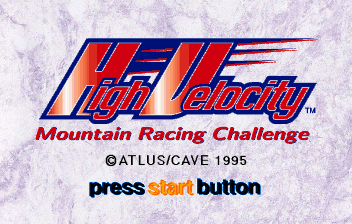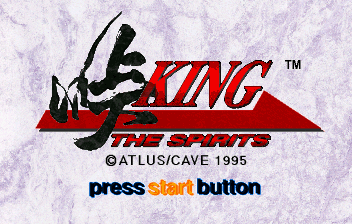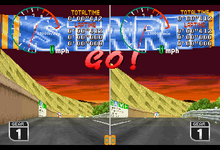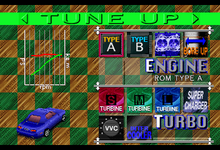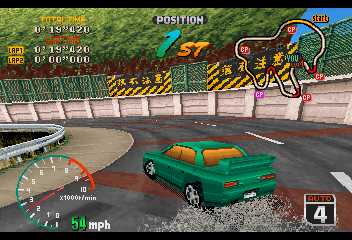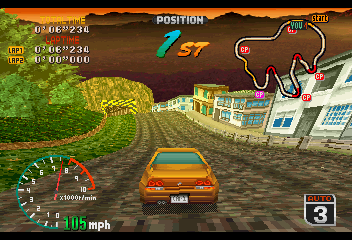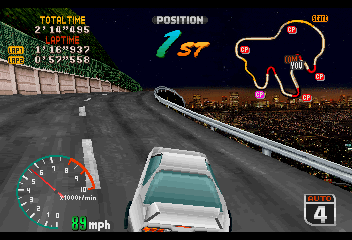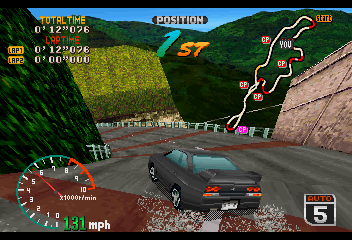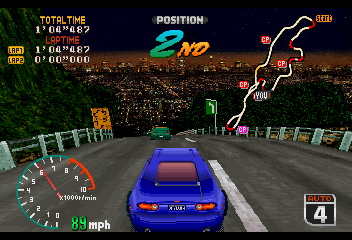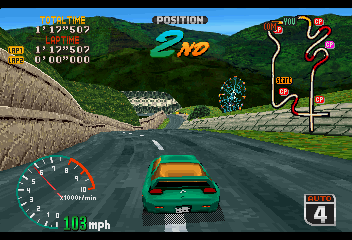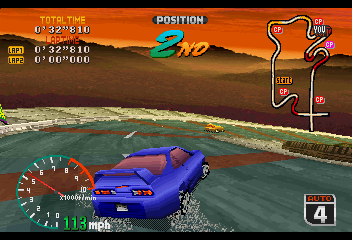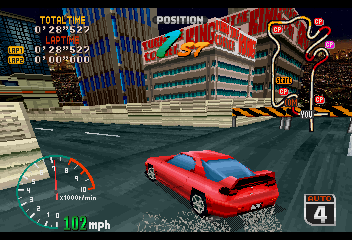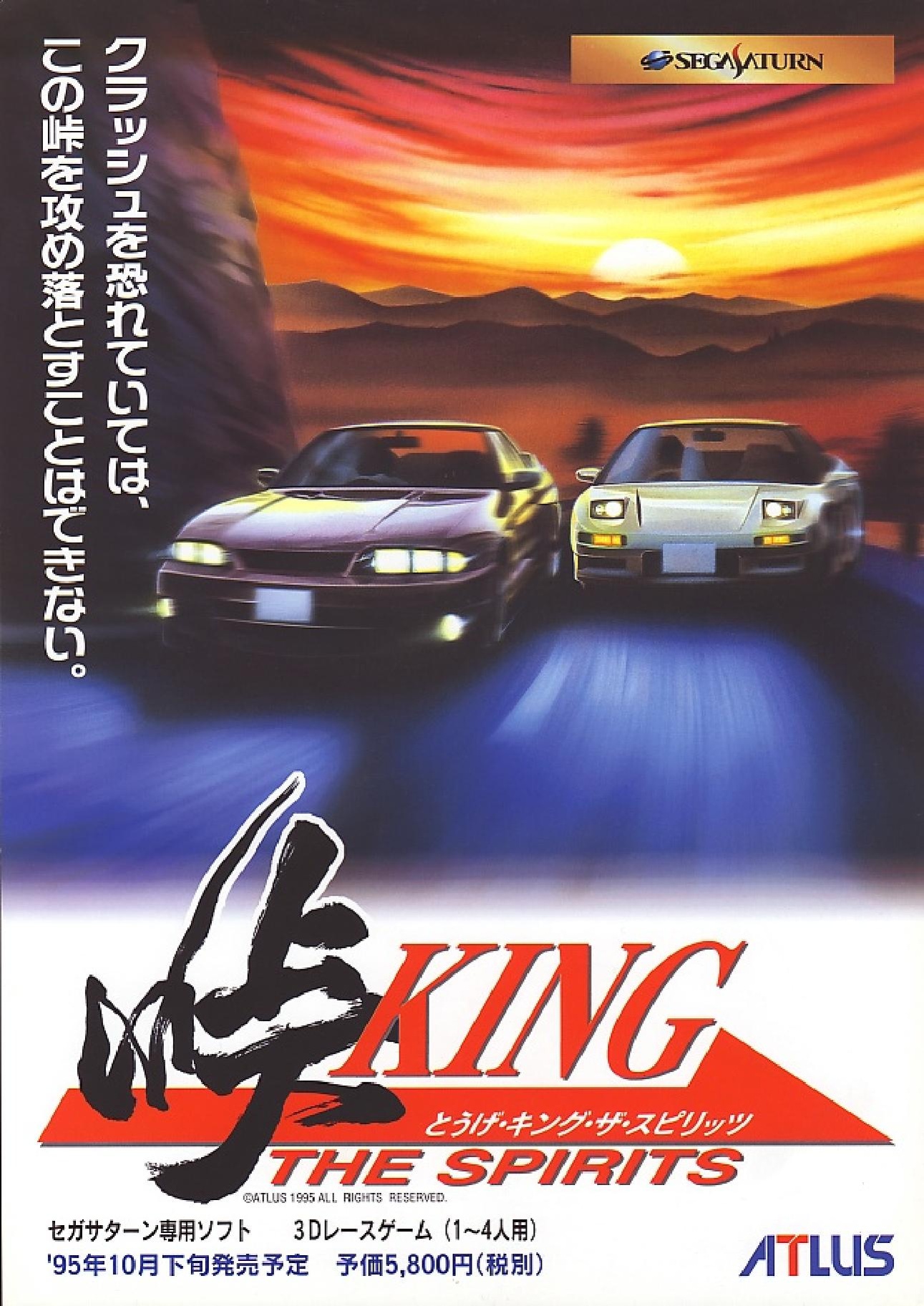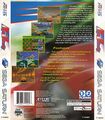High Velocity: Mountain Racing Challenge
From Sega Retro
| |||||||||||||||
| High Velocity: Mountain Racing Challenge | |||||||||||||||
|---|---|---|---|---|---|---|---|---|---|---|---|---|---|---|---|
| System(s): Sega Saturn | |||||||||||||||
| Publisher: Atlus (JP), Atlus Software (US) | |||||||||||||||
| Developer: Cave, Atlus | |||||||||||||||
| Sound driver: SCSP/CD-DA (7 tracks) | |||||||||||||||
| Peripherals supported: Arcade Racer | |||||||||||||||
| Genre: Racing[1][2] | |||||||||||||||
| Number of players: 1-2 | |||||||||||||||
|
High Velocity: Mountain Racing Challenge, known as Touge King the Spirits (峠キング・ザ・スビリッツ) in Japan, is a racing game developed by Cave and published by Atlus for the Sega Saturn. It was not released in Europe.
The game was followed by Touge King the Spirits 2.
Contents
Gameplay
As its names may suggest, High Velocity: Mountain Racing Challenge is based on "touge" (峠) racing, a branch of motorsports which sees two cars race head-to-head in the mountain passes of Japan. The roads consist of sharp turns, so success relies not only on moving fast, but also being able to successfully drift around corners.
With a standard control pad, the car is steered with ![]() and
and ![]() . It accelerates with
. It accelerates with ![]() using a manual transmission or with
using a manual transmission or with ![]() using an automatic transmission. Instead of choosing the transmission prior to starting the race, the player can switch freely between the two during the race depending on which button is used to accelerate. The manual transmission offers considerably more control through the winding turns of the game's mountain courses. It is downshifted with
using an automatic transmission. Instead of choosing the transmission prior to starting the race, the player can switch freely between the two during the race depending on which button is used to accelerate. The manual transmission offers considerably more control through the winding turns of the game's mountain courses. It is downshifted with ![]() and upshifted with
and upshifted with ![]() . The player can shift the car into reverse by holding
. The player can shift the car into reverse by holding ![]() and pressing
and pressing ![]() .
.
The car brakes with ![]() . If the player is not holding down the accelerator, the brake corresponds to the brake pedal, which stops the front wheels and slows the car. While the accelerator is depressed, the brake corresponds to the handbrake, which stops the rear wheels, inducing oversteer and causing the rear end of the car to kick out in a direction opposite to the front wheels. This is used deliberately for drifting, sliding the car sideways through a tight turn that exceeds the normal turning radius of the car. To drift effectively, the player must pull the handbrake as the car is entering the turn, then release the accelerator and counter-steer to correct the trajectory of the car, and finally reapply the accelerator to regain traction on the driven wheels and stabilize the movement of the car. Carefully timing the stages of the turn and managing the application of the brake and throttle are essential to drifting without losing control of the car, and players must master this technique to be competitive on the game's challenging mountain roads.
. If the player is not holding down the accelerator, the brake corresponds to the brake pedal, which stops the front wheels and slows the car. While the accelerator is depressed, the brake corresponds to the handbrake, which stops the rear wheels, inducing oversteer and causing the rear end of the car to kick out in a direction opposite to the front wheels. This is used deliberately for drifting, sliding the car sideways through a tight turn that exceeds the normal turning radius of the car. To drift effectively, the player must pull the handbrake as the car is entering the turn, then release the accelerator and counter-steer to correct the trajectory of the car, and finally reapply the accelerator to regain traction on the driven wheels and stabilize the movement of the car. Carefully timing the stages of the turn and managing the application of the brake and throttle are essential to drifting without losing control of the car, and players must master this technique to be competitive on the game's challenging mountain roads.
There are two views, a first-person perspective from the front of the car and a third-person view from behind the car, which are toggled with ![]() .
.
The game supports the Arcade Racer for analogue control. All of the controls are the same, except the car is steered by turning the wheel and shifted using the paddle shifters.
Modes
There are three game modes:
- King Battle: A single player chooses a course and a car and participates in a series of six heats against a computer-controlled opponent. Each heat is two laps, and heats can be played in any order, with progress saved to the Saturn's internal memory. If the player wins first place in every heat (in either direction), the player becomes "King of the Mountain" for that particular course.
- Versus Battle: Two players compete on any course over three laps, with either a horizontal or vertical split screen.
- Time Trial: A single player competes for the best time on any course over three laps, with no opponent.
Tune-Up
In the Versus Battle and Time Trial modes, players have access to a Tune-Up menu for customizing their cars before the race. Equipment is divided into the following categories:
- Engine: Choose between two additional engines with different torque curves, one tuned for faster acceleration and the other for higher top speeds. Toggle polished ports (to allow better airflow through the head) or bored cylinders (to increase engine displacement), which add horsepower.
- Turbo: Add forced induction: up to two turbos plus a supercharger can be equipped at the same time, in addition to variable valve control and an intercooler.
- Muffler: Choose between three muffler sizes.
- Suspension: Choose between two levels of suspension stiffness.
- Brakes: Choose between three levels of brakes.
- Tires: Choose between five tires with different tread patterns.
- Aero Parts: Choose between two levels of downforce.
- Etc: Toggle a roll bar, tower bar, limited slip differential, lighter body, or "good luck charm."
The game saves the player's customization to the Saturn's internal memory.
Cars
Neither the Japanese nor North American versions are licensed by any real car companies, thus the game presents the user with six fictional cars based on Japanese sports cars of the time. Players can also choose from six different colors.
| Type A | |
|---|---|
Resembles a fourth generation Nissan Skyline GT-R.
| |
| Type B | |
Resembles a first generation Honda NSX.
| |
| Type C | |
Resembles a first generation Mitsubishi Lancer Evolution. Despite being the only front-wheel drive car, it handles similarly to the other cars in the game.
| |
| Type D | |
Resembles a first generation Mazda MX-5.
| |
| Type E | |
Resembles a fourth generation Toyota Supra.
| |
| Type F | |
Resembles a third generation Mazda RX-7.
|
Courses
High Velocity features three courses of increasing difficulty, which can be raced either clockwise or anticlockwise (in three randomised times of day: day, dusk, and night). All three are based on real areas of Japan but have fictional circuit layouts.
Courses contain six checkpoints. The player's best times for each checkpoint on each course are saved to the Saturn's internal memory in the King Battle and Time Trial modes.
| Course 1: Full Counter | |
|---|---|
| Set at Mt. Tarumi in the Kantō region of Japan. It is the beginner course but nonetheless contains multiple turns that require players to learn how to drift effectively. | |
| Course 2: Power Slide | |
| Set at Hakone, a mountain resort in Kanagawa Prefecture, near Mt. Fuji. It is an intermediate course with narrow winding roads and a hairpin turn. | |
| Course 3: Full Boost | |
| Set at the base of a mountain overlooking the city of Ikoma in Nara Prefecture. It is an expert course with a 90-degree turn in the city center. |
Versions
Localised names
| Language | Localised Name | English Translation |
|---|---|---|
| English (US) | High Velocity: Mountain Racing Challenge | High Velocity: Mountain Racing Challenge |
| Japanese | 峠KING THE SPIRITS | Touge King the Spirits |
Comparisons
- Main article: High Velocity: Mountain Racing Challenge/Comparisons.
Magazine articles
- Main article: High Velocity: Mountain Racing Challenge/Magazine articles.
Promotional material
also published in:
- Strana Igr (RU) #2: "Mart 1996" (1996-xx-xx)[6]
Physical scans
| Sega Retro Average | |||||||||||||||||||||||||||||||||||||||||||||||||||||||||||||||||||||||||||||||||||||||||
|---|---|---|---|---|---|---|---|---|---|---|---|---|---|---|---|---|---|---|---|---|---|---|---|---|---|---|---|---|---|---|---|---|---|---|---|---|---|---|---|---|---|---|---|---|---|---|---|---|---|---|---|---|---|---|---|---|---|---|---|---|---|---|---|---|---|---|---|---|---|---|---|---|---|---|---|---|---|---|---|---|---|---|---|---|---|---|---|---|---|
|
| 68 | |
|---|---|
| Based on 17 reviews | |
Technical information
External links
- Sega of America webpage: Saturn
References
- ↑ File:TKtS Saturn JP Box Back.jpg
- ↑ 2.0 2.1 https://sega.jp/fb/segahard/ss/soft_licensee1.html (Wayback Machine: 2020-02-27 19:54)
- ↑ https://groups.google.com/g/rec.games.video.sega/c/j2FxcIYjh9Y/m/kBAmM7_YfncJ
- ↑ https://groups.google.com/g/rec.games.video.sega/c/KH9Apt7dJt0/m/f4y_qb_1JFIJ
- ↑ File:TKtS Saturn JP Flyer.pdf
- ↑ Strana Igr, "Mart 1996" (RU; 1996-xx-xx), page 87
- ↑ Famitsu, "1995-11-10,17" (JP; 1995-10-27), page 1
- ↑ Fun Generation, "01/96" (DE; 1995-12-20), page 58
- ↑ GameFan, "Volume 4, Issue 1: January 1996" (US; 199x-xx-xx), page 20
- ↑ Game Players, "Vol. 9 No. 1 January 1996" (US; 199x-xx-xx), page 85
- ↑ GamePro, "March 1996" (US; 1996-xx-xx), page 75
- ↑ Game Informer, "January 1996" (US; 199x-xx-xx), page 56
- ↑ MAN!AC, "02/96" (DE; 1996-01-10), page 38
- ↑ Mega Fun, "01/96" (DE; 1995-12-20), page 68
- ↑ Next Generation, "February 1996" (US; 1996-01-16), page 164
- ↑ Saturn Fan, "1996 No. 3" (JP; 1996-01-19), page 78
- ↑ Saturn+, "Christmas 1995" (UK; 1995-12-14), page 46
- ↑ Sega Power, "March 1996" (UK; 1996-01-18), page 30
- ↑ Sega Pro, "February 1996" (UK; 1995-12-28), page 66
- ↑ Sega Saturn Magazine, "December 1995" (JP; 1995-11-08), page 186
- ↑ Sega Saturn Magazine, "Readers rating final data" (JP; 2000-03), page 13
- ↑ Última Generación, "Enero 1996" (ES; 199x-xx-xx), page 78
- ↑ Video Games, "2/96" (DE; 1996-01-24), page 76
| High Velocity: Mountain Racing Challenge | |
|---|---|
|
Main page | Comparisons | Hidden content | Development | Magazine articles | Reception | Technical information | |
- Arcade Racer-compatible games
- 1-2 player games
- JP Saturn games
- All JP games
- US Saturn games
- All US games
- Saturn games
- 1995 Saturn games
- All 1995 games
- Saturn racing games
- All racing games
- Saturn games with Cinepak video
- Saturn games using the Sega Sound Library
- Saturn games with anamorphic widescreen support
- All games
- High Velocity: Mountain Racing Challenge
